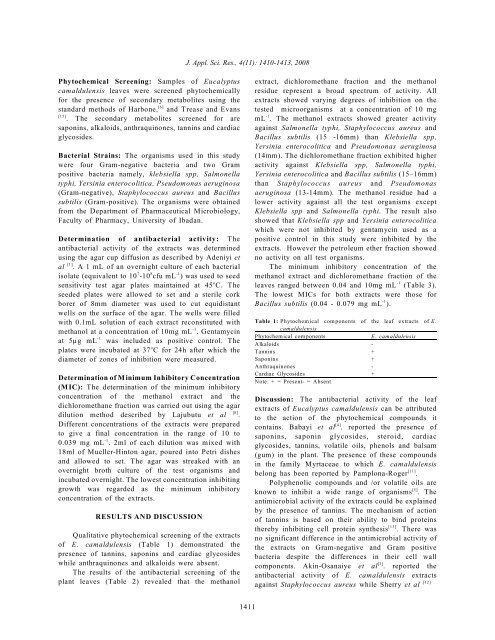The Antibacterial Activity of Leaf Extracts of Eucalyptus - Covenant ...
The Antibacterial Activity of Leaf Extracts of Eucalyptus - Covenant ...
The Antibacterial Activity of Leaf Extracts of Eucalyptus - Covenant ...
You also want an ePaper? Increase the reach of your titles
YUMPU automatically turns print PDFs into web optimized ePapers that Google loves.
Phytochemical Screening: Samples <strong>of</strong> <strong>Eucalyptus</strong><br />
camaldulensis leaves were screened phytochemically<br />
for the presence <strong>of</strong> secondary metabolites using the<br />
[6]<br />
standard methods <strong>of</strong> Harbone, and Trease and Evans<br />
[15]<br />
. <strong>The</strong> secondary metabolites screened for are<br />
saponins, alkaloids, anthraquinones, tannins and cardiac<br />
glycosides.<br />
Bacterial Strains: <strong>The</strong> organisms used in this study<br />
were four Gram-negative bacteria and two Gram<br />
positive bacteria namely, klebsiella spp, Salmonella<br />
typhi, Yersinia enterocolitica, Pseudomonas aeruginosa<br />
(Gram-negative), Staphylococcus aureus and Bacillus<br />
subtilis (Gram-positive). <strong>The</strong> organisms were obtained<br />
from the Department <strong>of</strong> Pharmaceutical Microbiology,<br />
Faculty <strong>of</strong> Pharmacy, University <strong>of</strong> Ibadan.<br />
Determination <strong>of</strong> antibacterial activity: <strong>The</strong><br />
antibacterial activity <strong>of</strong> the extracts was determined<br />
using the agar cup diffusion as described by Adeniyi et<br />
[1]<br />
al . A 1 mL <strong>of</strong> an overnight culture <strong>of</strong> each bacterial<br />
7 8 -1<br />
isolate (equivalent to 10 -10 cfu mL ) was used to seed<br />
o<br />
sensitivity test agar plates maintained at 45 C. <strong>The</strong><br />
seeded plates were allowed to set and a sterile cork<br />
borer <strong>of</strong> 8mm diameter was used to cut equidistant<br />
wells on the surface <strong>of</strong> the agar. <strong>The</strong> wells were filled<br />
with 0.1mL solution <strong>of</strong> each extract reconstituted with<br />
-1<br />
methanol at a concentration <strong>of</strong> 10mg mL . Gentamycin<br />
-1<br />
at 5µg mL was included as positive control. <strong>The</strong><br />
o<br />
plates were incubated at 37 C for 24h after which the<br />
diameter <strong>of</strong> zones <strong>of</strong> inhibition were measured.<br />
Determination <strong>of</strong> Minimum Inhibitory Concentration<br />
(MIC): <strong>The</strong> determination <strong>of</strong> the minimum inhibitory<br />
concentration <strong>of</strong> the methanol extract and the<br />
dichloromethane fraction was carried out using the agar<br />
[8]<br />
dilution method described by Lajubutu et al .<br />
Different concentrations <strong>of</strong> the extracts were prepared<br />
to give a final concentration in the range <strong>of</strong> 10 to<br />
-1<br />
0.039 mg mL . 2ml <strong>of</strong> each dilution was mixed with<br />
18ml <strong>of</strong> Mueller-Hinton agar, poured into Petri dishes<br />
and allowed to set. <strong>The</strong> agar was streaked with an<br />
overnight broth culture <strong>of</strong> the test organisms and<br />
incubated overnight. <strong>The</strong> lowest concentration inhibiting<br />
growth was regarded as the minimum inhibitory<br />
concentration <strong>of</strong> the extracts.<br />
RESULTS AND DISCUSSION<br />
Qualitative phytochemical screening <strong>of</strong> the extracts<br />
<strong>of</strong> E. camaldulensis (Table 1) demonstrated the<br />
presence <strong>of</strong> tannins, saponins and cardiac glycosides<br />
while anthraquinones and alkaloids were absent.<br />
<strong>The</strong> results <strong>of</strong> the antibacterial screening <strong>of</strong> the<br />
plant leaves (Table 2) revealed that the methanol<br />
J. Appl. Sci. Res., 4(11): 1410-1413, 2008<br />
1411<br />
extract, dichloromethane fraction and the methanol<br />
residue represent a broad spectrum <strong>of</strong> activity. All<br />
extracts showed varying degrees <strong>of</strong> inhibition on the<br />
tested microorganisms at a concentration <strong>of</strong> 10 mg<br />
-1<br />
mL . <strong>The</strong> methanol extracts showed greater activity<br />
against Salmonella typhi, Staphylococcus aureus and<br />
Bacillus subtilis (15 -16mm) than Klebsiella spp,<br />
Yersinia enterocolitica and Pseudomonas aeruginosa<br />
(14mm). <strong>The</strong> dichloromethane fraction exhibited higher<br />
activity against Klebsiella spp, Salmonella typhi,<br />
Yersinia enterocolitica and Bacillus subtilis (15–16mm)<br />
than Staphylococcus aureus and Pseudomonas<br />
aeruginosa (13-14mm). <strong>The</strong> methanol residue had a<br />
lower activity against all the test organisms except<br />
Klebsiella spp and Salmonella typhi. <strong>The</strong> result also<br />
showed that Klebsiella spp and Yersinia enterocolitica<br />
which were not inhibited by gentamycin used as a<br />
positive control in this study were inhibited by the<br />
extracts. However the petroleum ether fraction showed<br />
no activity on all test organisms.<br />
<strong>The</strong> minimum inhibitory concentration <strong>of</strong> the<br />
methanol extract and dichloromethane fraction <strong>of</strong> the<br />
-1<br />
leaves ranged between 0.04 and 10mg mL (Table 3).<br />
<strong>The</strong> lowest MICs for both extracts were those for<br />
-1<br />
Bacillus subtilis (0.04 - 0.079 mg mL ).<br />
Table 1: Phytochemical components <strong>of</strong> the leaf extracts <strong>of</strong> E.<br />
camaldulensis<br />
Phytochemical components E. camaldulensis<br />
Alkaloids -<br />
Tannins +<br />
Saponins +<br />
Anthraquinones -<br />
Cardiac Glycosides +<br />
Note: + = Present- = Absent<br />
Discussion: <strong>The</strong> antibacterial activity <strong>of</strong> the leaf<br />
extracts <strong>of</strong> <strong>Eucalyptus</strong> camaldulensis can be attributed<br />
to the action <strong>of</strong> the phytochemical compounds it<br />
[4]<br />
contains. Babayi et al . reported the presence <strong>of</strong><br />
saponins, saponin glycosides, steroid, cardiac<br />
glycosides, tannins, volatile oils, phenols and balsam<br />
(gum) in the plant. <strong>The</strong> presence <strong>of</strong> these compounds<br />
in the family Myrtaceae to which E. camaldulensis<br />
[11]<br />
belong has been reported by Pamplona-Roger .<br />
Polyphenolic compounds and /or volatile oils are<br />
[5]<br />
known to inhibit a wide range <strong>of</strong> organisms . <strong>The</strong><br />
antimicrobial activity <strong>of</strong> the extracts could be explained<br />
by the presence <strong>of</strong> tannins. <strong>The</strong> mechanism <strong>of</strong> action<br />
<strong>of</strong> tannins is based on their ability to bind proteins<br />
[13]<br />
thereby inhibiting cell protein synthesis . <strong>The</strong>re was<br />
no significant difference in the antimicrobial activity <strong>of</strong><br />
the extracts on Gram-negative and Gram positive<br />
bacteria despite the differences in their cell wall<br />
[3]<br />
components. Akin-Osanaiye et al . reported the<br />
antibacterial activity <strong>of</strong> E. camaldulensis extracts<br />
[12]<br />
against Staphylococcus aureus while Sherry et al
















